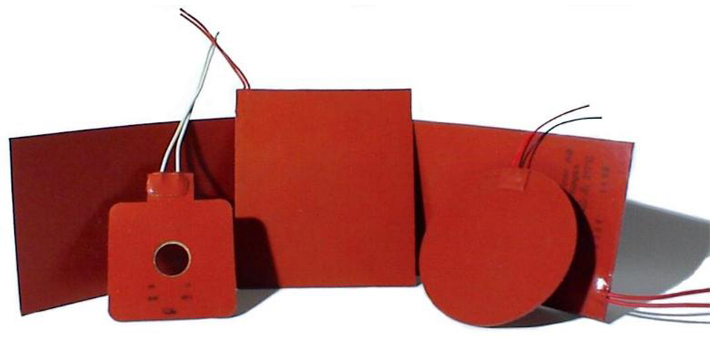


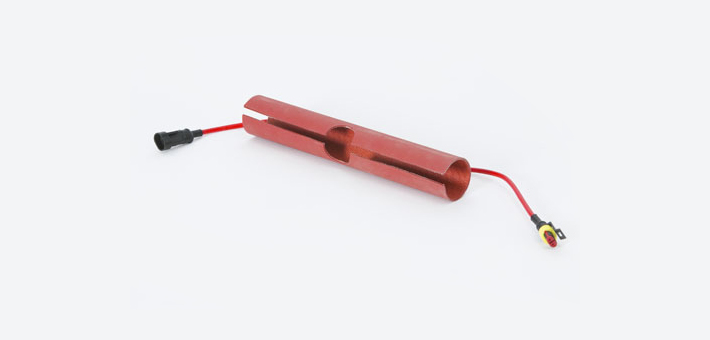
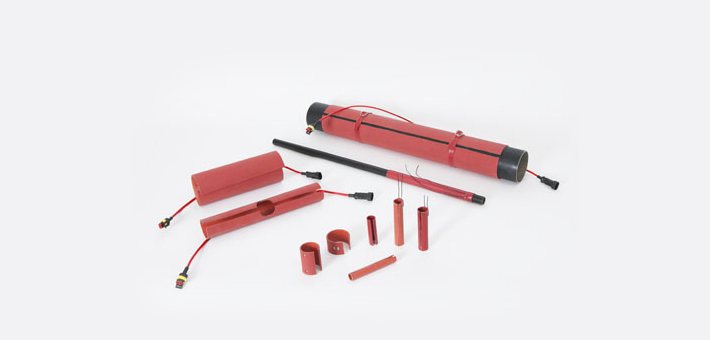
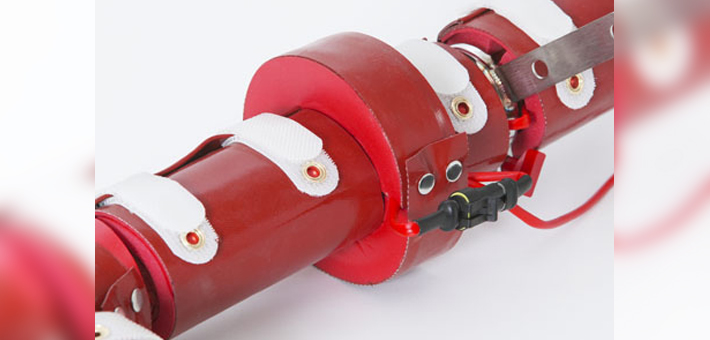
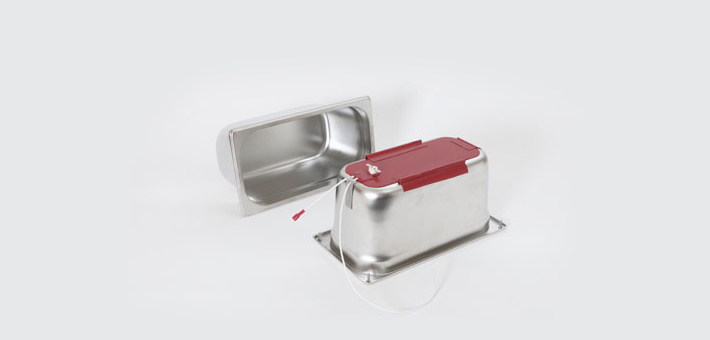
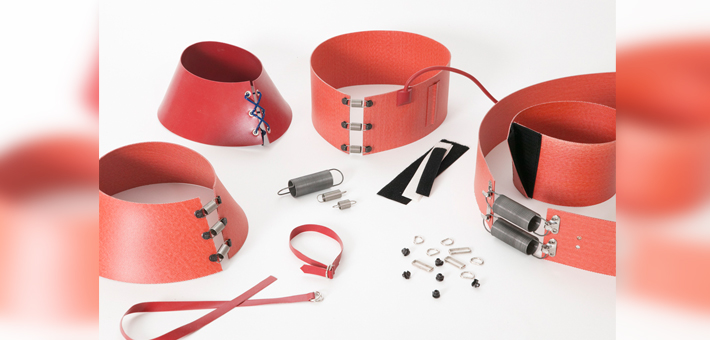
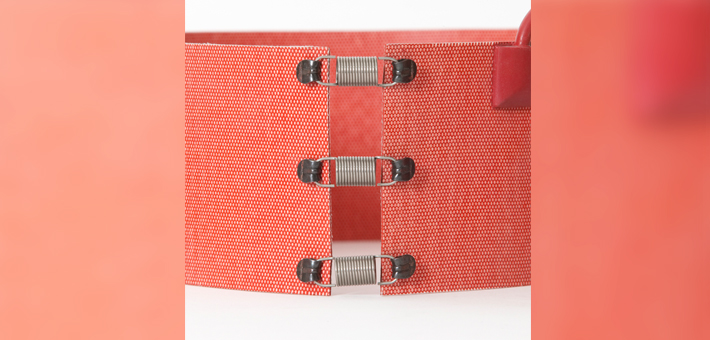

Silicone heaters are resistant to permanent temperatures up to 200 °C, with self-adhesive foil 180 °C should not be exceeded. Higher temperatures up to 230 °C are possible for a short time without destroying the heater. The temperature that will be reached on the silicone heater surface, generally is not easy to predict, as there are so many influencing factors determined by the application. In addition to the power, resp. surface load, this also includes mass and type of the material to be heated (thermal conductivity, surface quality, etc.) installation / assembly situation (bonded, vulcanised, clamped, etc.), ambient temperature, air movement and, of course, the control technology used.
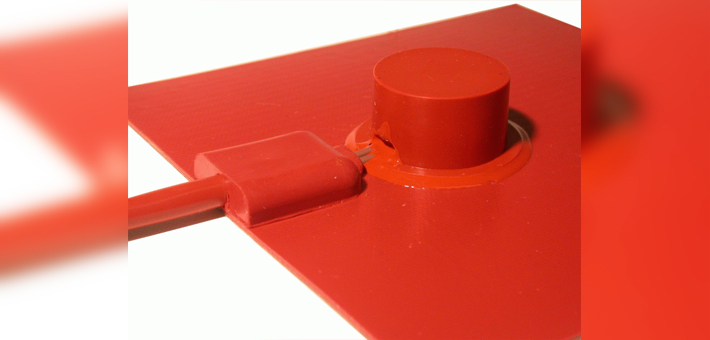


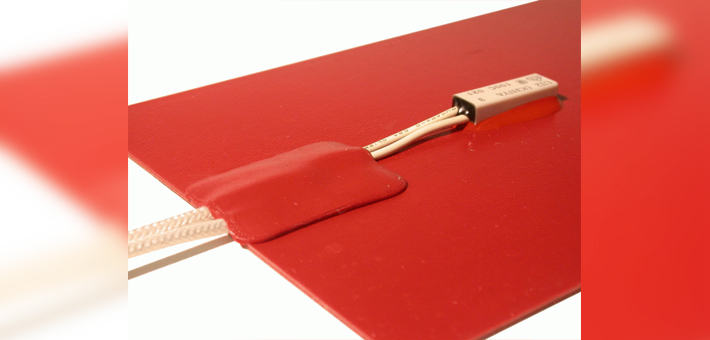
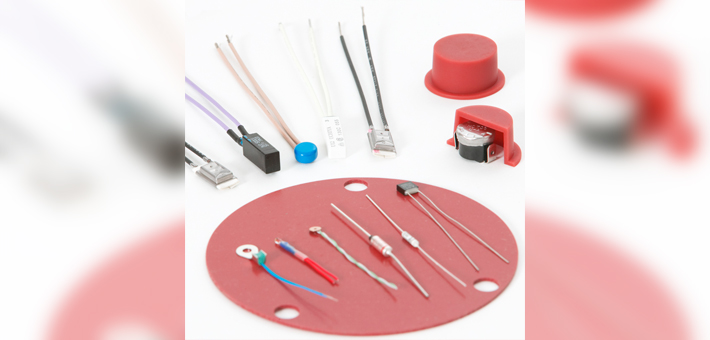
As an aid to orientation you will find here a table showing the temperature that can occur at a silicone heater depending on the watt density in an unregulated state.
Surface Temperatures of Silicone Mat HeatersTest conditions:
download pdf- Silicone heater mat, vulcanised to a 1,5 mm aluminium plate
- Ambient temperature 20 °C
- Still air
- Heating element in a horizontal position
- Measured in a steady state condition
| Watt density of heating element [W/cm²] | Surface temperature on mat [°C] |
|---|---|
| 0,05 | 40 |
| 0,075 | 60 |
| 0,1 | 70 |
| 0,125 | 80 |
| 0,15 | 90 |
| 0,2 | 105 |
| 0,25 | 121 |
| 0,3 | 135 |
| 0,35 | 150 |
| 0,4 | 164 |
| 0,45 | 176 |
| 0,5 | 188 |
| 0,55 | 200 |
| 0,6 | 210 |
| 0,65 | 220 |
| 0,7 | 230 |
| 0,75 | 238 |
| 0,8 | 247 |
| 0,85 | 253 |
| 0,9 | 259 |
| 0,95 | 265 |
| 1,0 | 270 |
| 1,1 | 280 |
| 1,2 | 290 |
| 1,3 | 300 |
| 1,4 | 310 |
| 1,5 | 320 |
| 1,6 | 330 |
| 1,7 | 340 |
| 1,8 | 350 |
| 1,9 | 360 |
| 2,0 | 370 |
As a rule of thumb: the lower the surface load, the longer the life of the silicone mat heater. In order to avoid overheating, we recommend not to exceed a watt density of 0.8 W/cm2. Some of our customers have applications in which silicone rubber heaters with 2 W/cm2 or more are used without any issues. This is mainly dependant on the thermal conductivity of the material being heated, the higher the thermal conductivity the higher the power density can be so the applications in which this is possible, can only be found out by testing. Because of the large number of temperature influencing variables that cannot be influenced by us, we do not offer warranty for overheated silicone heating elements with a surface load of more than 1.3 W/cm2.
Application examples for silicone heating mats include: canteen kitchen technology / catering, anti-fog and anti-freeze applications, tool or plate heating, blister packaging machines, hot presses, 3D printers, granulate dryers, laboratory and medical equipment, repair of composite materials and much more.
When designing silicone rubber heaters, the designer has almost unlimited degrees of freedom. This applies to the minimum and maximum dimensions within wide limits, as well as for shapes and cut-outs or holes and bushings of any kind. The excellent shape flexibility of silicone heaters enables heating of cylindrical, conical or rounded surfaces. It is also possible to preform the flexible silicone heater during production for diameters as small as 12 mm. This is practiced, for example, for pipe line heating or bodies with shape transitions or small deflection radii. The ability to pre-form the heater will also depend on the length of the tubular part. The following applies here: the longer the more rigid, the more effective the preforming is. Spiral silicone rubber heaters are also available for flexible pipes and hoses down to 6mm diameter.
Different silicone materials are used, depending on whether the flexible silicone heater is frequently moved in the application, must be particularly thin or must meet fire behaviour regulations. Normally, you describe your requirements and the application to us and we will then select the appropriate material.
10 Advantages of our silicone heating mats
- Low weight
- Easy installation
- Moisture proof
- Easy cleaning
- Minimum space requirement
- Integrated temperature sensors
- Integrated temperature switches / fuses
- From single pieces to large series
- Every shape possible
- Short heat up times
Technical data for Silicone Heaters vs. Kapton Polyimide Heaters and Polyester Heaters
| Flexible Heaters (up to 200°C) |
Flat Heating Elements (over 200°C) |
||||||||||||||||||||||||||||||||||||||||||||||||||||||||||||||||||||||||||||||||||||||||||||||||||
|---|---|---|---|---|---|---|---|---|---|---|---|---|---|---|---|---|---|---|---|---|---|---|---|---|---|---|---|---|---|---|---|---|---|---|---|---|---|---|---|---|---|---|---|---|---|---|---|---|---|---|---|---|---|---|---|---|---|---|---|---|---|---|---|---|---|---|---|---|---|---|---|---|---|---|---|---|---|---|---|---|---|---|---|---|---|---|---|---|---|---|---|---|---|---|---|---|---|---|---|
| Silicone | Kapton | Polyester | Micanite | Phlogopit | |||||||||||||||||||||||||||||||||||||||||||||||||||||||||||||||||||||||||||||||||||||||||||||||
| Wire Wound | Etched Foil | ||||||||||||||||||||||||||||||||||||||||||||||||||||||||||||||||||||||||||||||||||||||||||||||||||
| * higher surface loads can be achieved, depending on the application, with very good heat consumption and fast control (No warranty claims can be derived from this table) |
|||||||||||||||||||||||||||||||||||||||||||||||||||||||||||||||||||||||||||||||||||||||||||||||||||
| Continuous temperature resistance | -60 °C - 200 °C | -60 °C - 200 °C | -40 °C - 200 °C | -30 °C - 90 °C | 350 °C | 450 °C | |||||||||||||||||||||||||||||||||||||||||||||||||||||||||||||||||||||||||||||||||||||||||||||
| Continuous temperature resistance with self adhesive foil | -60 °C - 180 °C | -60 °C - 180 °C | -40 °C - 180 °C | -30 °C - 90 °C | - | - | |||||||||||||||||||||||||||||||||||||||||||||||||||||||||||||||||||||||||||||||||||||||||||||
| Short term temperature resistance | 250 °C | 200 °C | 200 °C | 100 °C | 700 °C | 900 °C | |||||||||||||||||||||||||||||||||||||||||||||||||||||||||||||||||||||||||||||||||||||||||||||
| Recommended max. watt density* | 0,8 W/cm² | 0,8 W/cm² | 0,8 W/cm² | 0,2 W/cm² | 4,0 W/cm² | 5,0 W/cm² | |||||||||||||||||||||||||||||||||||||||||||||||||||||||||||||||||||||||||||||||||||||||||||||
| Power tolerance | +5 / -10% | +5 / -10% | +5 / -10% | +/-10% | +5 / -10% | +5 / -10% | |||||||||||||||||||||||||||||||||||||||||||||||||||||||||||||||||||||||||||||||||||||||||||||
| max. dimension | 940 x 3000 mm | 595 x 2500 mm | 285 x 550 mm | 1000 x 600 mm | 2000 x 1000 mm | 2000 x 1000 mm | |||||||||||||||||||||||||||||||||||||||||||||||||||||||||||||||||||||||||||||||||||||||||||||
| min. dimension | 30 x 30 mm | 20 x 20 mm | 25 x 25 mm | 25 x 25 mm | 30 x 30 mm | 30 x 30 mm | |||||||||||||||||||||||||||||||||||||||||||||||||||||||||||||||||||||||||||||||||||||||||||||
| min. height | 1,1 - 3,0 mm | 0,8 - 1,5 mm | 0,2 mm | 0,2 mm | 2,0 mm (metal p.: 4,0 mm) |
2,0 mm (metal p.: 4,0 mm) |
|||||||||||||||||||||||||||||||||||||||||||||||||||||||||||||||||||||||||||||||||||||||||||||
| Dimension tolerance | +/- 1 mm | +/- 1 mm | +/- 1 mm | +/- 1 mm | +/- 1 mm | +/- 1 mm | |||||||||||||||||||||||||||||||||||||||||||||||||||||||||||||||||||||||||||||||||||||||||||||
| Quantities | from 1 piece | from 1 piece | from 1 piece | from 25 pieces | from 1 piece | from 1 piece | |||||||||||||||||||||||||||||||||||||||||||||||||||||||||||||||||||||||||||||||||||||||||||||
| min. bend radius | 5 mm | 5 mm | 2 mm | 5 mm | - | - | |||||||||||||||||||||||||||||||||||||||||||||||||||||||||||||||||||||||||||||||||||||||||||||
| max. IP-protection | IP65 | IP65 | IP64 | IP64 | - | - | |||||||||||||||||||||||||||||||||||||||||||||||||||||||||||||||||||||||||||||||||||||||||||||
| Adhesive foil possible | yes | yes | yes | yes | no | no | |||||||||||||||||||||||||||||||||||||||||||||||||||||||||||||||||||||||||||||||||||||||||||||
| UL possible | yes | yes | no | yes | no | no | |||||||||||||||||||||||||||||||||||||||||||||||||||||||||||||||||||||||||||||||||||||||||||||
Silicone rubber heater options
In the chapter Silicone rubber heater options, we show you the great design freedom you have with our silicone heating elements for solving your application-specific heating task. We show you which geometries and shapes are possible, how heating mats are constructed and manufactured, which fastening options are available and how silicone heating elements can be optimised for the heating task in terms of thermal and safety with special insulation materials, connection designs and electronic safety components.
Geometry of silicone heating mats
- Shapes / cut-outs / holes Can be provided according to your wishes
- If necessary, a cutting tool must be created (e.g. for a particularly large number of holes or narrow position tolerances)
- Between two holes and to the edge we need at least 10 mm insulation distance, otherwise the area remains unheated
Production process of flexible silicone rubber heaters
There are two different manufacturing techniques for silicone rubber heaters, which have different benefits depending on the number of units, geometry, layout of heating tracks, thermal load and the application.
- wire wound
For lot sizes below 50 pieces silicone heaters are usually manufactured using resistance wire laid manually in a meandering pattern with the help of a pin board. If necessary, a special heating wire can be used, which withstands mechanical stresses by thermal expansion even better. This wire is used especially in very large silicone heating mats, or mat heaters which are moved more frequently. Since a pin board is sufficient as a tool, only low design costs are incurred, which makes this manufacturing process interesting for individual production with low volumes.
- etched foil
For larger batch sizes or silicone heaters with many holes and complex layouts, the heating tracks are produced by vulcanising a special alloy foil to the silicone and then printing and etching the foil to create the circuit. The heat distribution in these heaters is more homogeneous than in wire wound, as the foil tracks are flat and the distances between the tracks are smaller than with wire. Furthermore, the degree of automation in this process is higher, which increases reproducibility and, not least, cost-effectiveness for larger quantities. Varying power densities across the surface of the silicone heating element can easily be designed using etch foil technology.
Mounting options for silicone rubber heaters
There are many different ways to attach silicone heaters. Which is the best solution depends primarily on the application, but also on the shape and size of the heating mat. In the case of a high surface load on the silicone mat heater, for example, a good heat transfer is particularly important and fastening with silicone straps is not recommended.
self-adhesive foil
- not removable
- good heat transfer
- temperature resistant up to 180 °C
- suitable for any shape and size
- not applicable for pre-rounded silicone heater mats
- download bonding instructions for flexible heaters here
press-fit
- Removable
- temperature resistant up to 200 °C
- termination area and attachments such as limiters and the connection area must be left out in the pressure plate
- screw-on pressure plate required
- risk of partial overheating due to inhomogeneous contact pressure
- risk of mechanical damage of the silicone heater by burrs or sharp edges on the metal plates
vulcanising
- not removable
- temperature resistant up to 200 °C
- Ideal heat transfer
- Can only be made in the factory by the manufacturer
Bonding with silicone adhesive
- Not removable
- temperature resistant up to 200 °C
- Very good heat transfer
- alternative to vulcanisation, which can also be carried out by the customer
- download bonding instructions for silicone rubber heating pads here
Silicone straps
- removable
- for cylindrical or rounded contact surfaces
- suitable for preformed flexible silicone rubber heaters up to Ø 250 mm
- wears quickly when used regularly
- width: 12 mm (25 mm for larger silicone heaters)
- temperature resistant up to 180 °C
Velcro
- removable
- for cylindrical or rounded contact surfaces
- sewn direct or indirect on heater
- area around Velcro is not heated, when sewn on direct
- width: 15 / 20 / 25 / 50 / 100 mm
- Velcro resistant up to 80 °C
hooks & springs
- removable
- Variable clamping elements (hooks, eyes, straps, springs)
- Under hooks / eyelets and in the clamping area unheated
- Also suitable for conical shapes
- Springs suitable from Ø 100 mm
Sensors
The silicone heaters can be equipped with sensors, limiters and fuses of all kinds. In the following we present the most common variants, which are usually available in production. However, it is also possible that you provide parts that we apply to the silicon heater pad.
In your design, you should note that these components usually cannot be installed flush with the heating surface.
Pt 100 / PT 1000 / thermocouple type J / NTC / PTC
- For temperature reading and further processing by a controller
- Can be placed anywhere on the silicone heater surface (if the position is not defined, the sensors are placed near the connection area)
- It is not possible to fit SMD parts
Temperature limiters / fuses
Uchiya
- 50 – 140 °C in 10 °C-steps
- Overtemperature protection
- Bimetal switch
- Encapsulated design - low overall height
- Appr. 10,000 switching cycles
- Suitable for 230V AC / max. 10A
- Hysteresis 30 – 40 °C
1/2" Disk
- 5 °C, 13 °C, 20 – 200 °C in 10 °C-steps
- Overtemperature protection
- Bimetal switch
- Open design – must be covered with silicone hat
- Appr. 100.000 switching cycles
- Suitable for 230V AC / max. 10 A
- Hysteresis 10 – 20 °C
- Can be installed in leads for anti-freeze applications
Diverse fuses
- Single Shot Over temperature protection
- When the fuse is tripped, the circuit is interrupted until the heater is replaced or the fuse is reset (depending on the type of fuse)
- Typical models are NEC/Schott SF-R andMicrotemp G4
Various special components
- Pockets for capillary thermostats and sensor probes, available in Ø 3,4, 6 und 8 mm
- Length as required
- Pockets, hats and enclosures for all kinds of components
Leads for silcone rubber heaters
You are free to choose the type, length and position of the connection cable. Please note that the connection area is always slightly thicker than the rest of the silicone heater pad. You can see this very well on the following pictures, which show the most common options. If you do not specify any special requirements, we generally assume 1000 mm PTFE leads in the middle of the short side. The length and type of the connection cable can be easily changed for subsequent orders of an existing design; a new design / tool must be created to change the position.
PTFE-leads (standard)
- Low construction height
- Resistant up to 190 °C
- Flexible and robust
- Max. IP62
Silicone leads
- Low construction height
- Resistant up to 180 °C
- Very flexible but less robust than PTFE leads
- Max. IP64
Silicone cable
- Resistant up to 180 °C
- Robust
- No single wires (i.e. solid single wire)
- 5adrig with PT 100 available
- IP64 standard (IP65 possible)
Ground lead
- Has to be contacted on site as silicone heating mats do not have metal parts on the outside
Various other leads and cable
- (HO7RN-F cable)
- PVC
Protection sleeve
In the case of silicone heaters, leads are less often fitted with protective hoses than is the case with most other types of heaters. Thermal protection in particular plays only a subordinate role due to the comparatively low operating temperatures. For mechanical protection, however, there are options such as silicone/fiberglass sleeve or heat-shrinkable tubing.
The use of a protective conduit above the leads is recommended as a second insulation and in order to be able to lay the leads better. Fixing the hose under the connection pad is advisable, but also leads to a thicker termination area.
Silicone/Fibre glass sleeve
- Ø 3 – 12 mm
- Resistant up to 235 °C
Silicone foam
Silicone foam can be applied to the silicone rubber heating element for thermal insulation. A main field of application for such insulated silicone heaters is e.g. semiconductor production. Here, vacuum piping systems are heated and insulated in this way.
Silicone heating mats insulated with silicone foam
- Shore-hardness: 42 +/- 5
- Density: 250 +/- 40 kg/m3
- Resistant up to 230 °C
- UL
- Thickness:
- 3 mm (also adhesive)
- 5 mm (also adhesive)
- 8 mm
- 12 mm
For thermal insulation
As protection for termination and sensors etc.
Insulation and silicone heating jackets for piping systems
- Tubular forms for pipes, cuboid forms for pumps, valves etc.
Conformities & standards
Our flexible silicone rubber heating elements are manufactured according to the strictest test criteria and meet all relevant standard requirements and safety specifications as far as these are applicable due to the nature of the product. General certificates of conformity relating to organizations or product groups can be downloaded in our download centre under Service > Quality. Product-specific confirmations are available on request.
certifications
- CE
- RoHS
- UL/CSA (Optional with surcharge, only possible with UL-CSA approved accessories)
- VDE (Optional with surcharge, only possible with VDE approved accessories)
- EAC (Optional with surcharge)

Printing of Silicone Heaters
Inkjet printing
- black
- Used for low volume orders
- Without additional costs
- Can include different details on different batches (serial number)
- Cannot include logo
- Semi-permanent (can be rubbed off)
Silicone ink screen printing
- White
- Used for high volume orders
- Can include logos (in a single white colour)
- Additional costs for printing screen (usually included in tooling costs for etch foil silicone heaters)
- Requires a new tooling when details change
- permanent
Silver label on cable or leads
- for silicone mat heaters that are difficult to position under inkjet printer or very small heater pads where there is not enough space
Special silicone heaters
The variety of applications for silicone heaters seems almost endless. Nevertheless, some standards have been developed for common applications, which you can see in the following chapters.
One common application for standardised silicone heaters is even dedicated a separate product chapter: it is the heating of drums and other containers. There you can find out more about the huge variety of choice in the barrel heaters and container heaters product area.
Preformed heaters
Silicone heaters can be pre-formed to suit a wide variety of pipework and vessels. These silicone heating elements will hold their shape without fixings in certain applications. We can also supply preformed silicone heating mats and pads with separate fixings for more dynamic or sensitive applications. This type of flexible silicone heater can be heavily customised to suit a wide variety of applications.
In applications where a flexible silicone rubber heater is required to fit small diameter pipe-work a more precise fit can be obtained by using the pre-formed heater pad or mat variant. These preformed heaters can be supplied with separate straps for fixing or can be permanently installed using room temperature vulcanizing silicone adhesive or self-adhesive backing. To help avoid potential heat losses Freek can also offer preformed heating mats and pads with insulation foam bonded to the spine of the heater.
Specifics of Preformed silicone heater mats/pads
- Etched foil & wire wound execution
- Diameter range: Ø 10 mm to Ø 200 mm
- Thickness of pre-formed silicone heaters: 1,5 mm to 2,2 mm
- Installation: straps, vulcanizing, self-adhesive foil
- Good resistance of silicone heaters to: weather, aging, fungus, bacteria, acetone, alcohol, formic acid, brake fluid, acetic acid, greases, hydrochloric acid 10%, sulphuric acid 10%, waxes, plasticisers
- Bespoke heaters for bigger diameters or different lengths available on request
- Additional sensor (thermocouple, PT 100) for external temperature control available on request
Spiral heaters
Silicone spiral heaters have been specifically designed to be suitable for straight, curved or rigid pipework. Being robust and easy to install, Silicone pipe heating cables are the ideal solution for pipework with small diameters. Stretchable Spiral Silicone Heaters are appropriate for use in gas delivery, semiconductor processes, frost protection, anti-condensation and heat loss maintenance.
Pre-Formed Stretchable Spiral Silicone Rubber Heaters
- Suitable for tubes and flexible pipes and hoses with Ø 6,35 mm (1/4")
- Can be used up to Ø 12 mm (the length of the stretchable silicone spiral heater is reduced accordingly)
- Robust spiral heating element (spiral wire on a fiberglass cord) encased between two layers of silicone rubber
- Thickness of silicone spiral strip heater: 2,2 mm
- 500 mm PTFE-leads
- Termination area: 25 x 36 mm
- Bespoke heaters for bigger diametres or different lengths available on request
- Additional sensor (thermocouple, PT 100) for external temperature control available on request
| Article no. | Nominal length for tube-Ø 6,35 mm (1/4") (80% surface coverage) |
Extended length for tube-Ø 6,35 mm (1/4") (60% surface coverage) |
power (at 240V) |
power density (W/cm2) |
|---|---|---|---|---|
| 3854.020 | 375 mm | 440 mm | 19,5W | 0,27 |
| 3855.010 | 475 mm | 550 mm | 25W | 0,27 |
| 3857.007 | 612,5 mm | 720 mm | 33W | 0,28 |
| 3858.003 | 780 mm | 900 mm | 45W | 0,3 |
| 3850.013 | 1020 mm | 1150 mm | 52W | 0,27 |
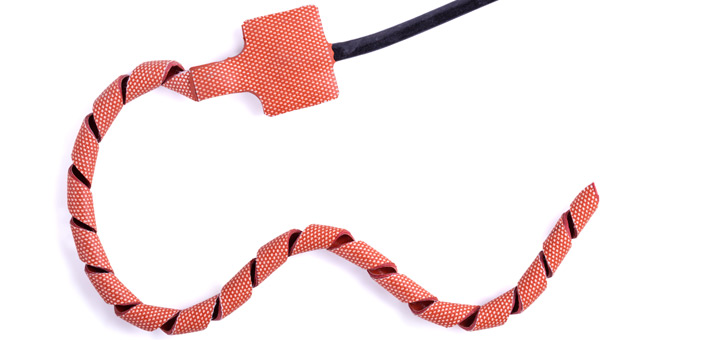

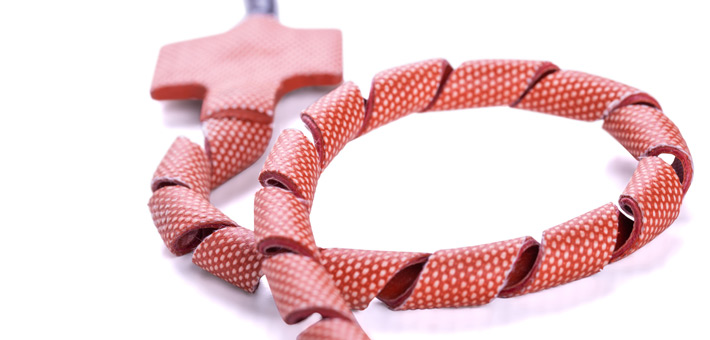
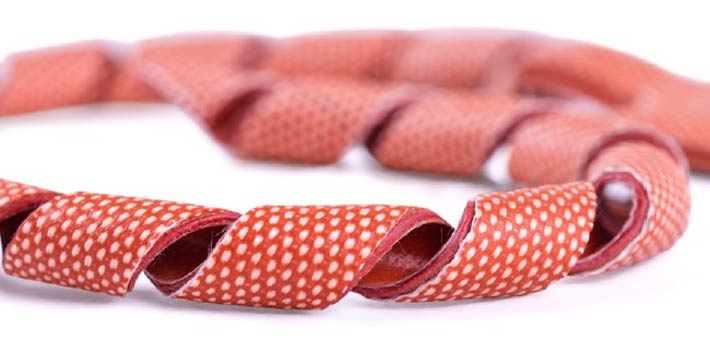

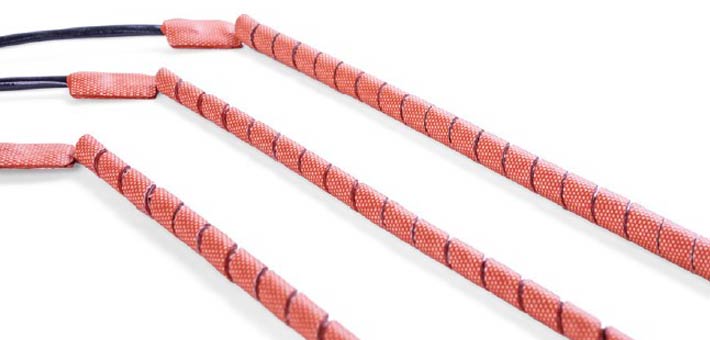
Gas & Pump line heaters
Insulated Gas and pump line heaters consistently heat the lines and provide a simple solution to prevent frost damage and condensation build up while saving energy at the same time.
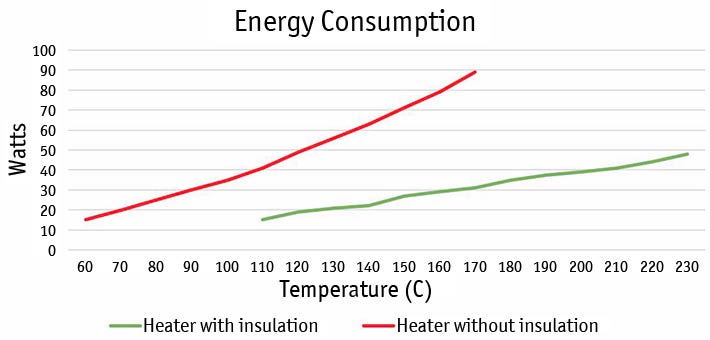
Silicone gas &pump line heaters are most frequently used as part of the semi-conductor process, in which gases such as Tetraethyl Orthosilicate (TEOS), Boron Trichloride (BCl3), Aluminium Chloride (AlCl3), Chlorine Triuoride (ClF3) and Dichlorosilane (DCS) condense at low temperatures. Should this occur, it could result in wafer defect.
Semiconductor Gas line heaters and any other insulated silicone line heaters can be designed to specific power densities, use customer specified thermal controls, parallel and series connections, inbuilt neon temperature/fault indication, customer specified connectors, gate and isolation valves, pipe assemblies, pumps, generic valves and pipe runs including T-sections, elbows and bellows.
Specifics of Insulated Silicone gas line and pump line heaters
- Etch Foil &Wire Wound execution
- Diameter range: Ø 10 mm to Ø 200 mm
- Thickness of silicone heaters: 1,5 mm to 2,2 mm
- Insulation material: Closed cell silicone foam 8 mm (0.25 in) / 12 mm (0.5 in)
- Installation: snap fasteners, Velcro, strap &buckle
- Good resistance to: weather, aging, fungus, bacteria, acetone, alcohol, formic acid, brake fluid, acetic acid, greases, hydrochloric acid 10%, sulphuric acid 10%, waxes, plasticisers
- Bespoke heaters for bigger diametres or different lengths available on request
- Thermal control options: PT100 / PT1000, thermocouples, Bi-metal thermostats, thermal fuses, target temperature visual indicators, thermistors


Enclosure heaters
Pre-attached to a mounting plate, electric silicone enclosure heaters provide ideal protection against frost and condensation in enclosures containing electronic equipment such as ATM's temperature control panels and control valve housings.
As standard stock items, electrical enclosure heaters with thermostats can be supplied at 50, 100 and 200 watt, for 240V supply. The heater assemblies can be supplied with either integral or remote 15°C air temperature sensing thermostats.
Specifics of Silicone Enclosure heaters
- Standards in 240 V: 50W, 100W, 200W
- All standard heaters with and without mounted thermostat (15°C)
- Etch Foil execution for precise, even heating
- Integral or remote air temperature sensing thermostats ensure heater operation in condensation forming and other air heating application conditions
- Short lead times
- Heaters supplied pre-attached to mounting plate for easy installation
Determination of the recommended minimum power
| Temperature above ambient |
Total enclosure surface area (m2) | ||||||||||||||||||||||||||||||||||||||||||||||||||||||||||||||||||||||||||||||||||||||||||||||||||
|---|---|---|---|---|---|---|---|---|---|---|---|---|---|---|---|---|---|---|---|---|---|---|---|---|---|---|---|---|---|---|---|---|---|---|---|---|---|---|---|---|---|---|---|---|---|---|---|---|---|---|---|---|---|---|---|---|---|---|---|---|---|---|---|---|---|---|---|---|---|---|---|---|---|---|---|---|---|---|---|---|---|---|---|---|---|---|---|---|---|---|---|---|---|---|---|---|---|---|---|
| 0,19 | 0,28 | 0,37 | 0,46 | 0,56 | 0,7 | 0,84 | 0,93 | 1,39 | 1,86 | 2,32 | 2,79 | 3,72 | 4,65 | ||||||||||||||||||||||||||||||||||||||||||||||||||||||||||||||||||||||||||||||||||||||
| Uninsulated Enclosures* | |||||||||||||||||||||||||||||||||||||||||||||||||||||||||||||||||||||||||||||||||||||||||||||||||||
| * For insulated enclosures estimated wattage can be devided by four | |||||||||||||||||||||||||||||||||||||||||||||||||||||||||||||||||||||||||||||||||||||||||||||||||||
| 11 °C | 30 W | 40 W | 55 W | 70 W | 80 W | 100 W | 120 W | 135 W | 205 W | 270 W | 335 W | 405 W | 540 W | 670 W | |||||||||||||||||||||||||||||||||||||||||||||||||||||||||||||||||||||||||||||||||||||
| 22 °C | 55 W | 80 W | 110 W | 135 W | 160 W | 200 W | 245 W | 270 W | 405 W | 540 W | 670 W | 805 W | 1075 W | 1340 W | |||||||||||||||||||||||||||||||||||||||||||||||||||||||||||||||||||||||||||||||||||||
| 33 °C | 90 W | 120 W | 160 W | 205 W | 245 W | 300 W | 365 W | 405 W | 605 W | 805 W | 1005 W | 1210 W | 1610 W | 2010 W | |||||||||||||||||||||||||||||||||||||||||||||||||||||||||||||||||||||||||||||||||||||
| 44 °C | 110 W | 160 W | 215 W | 270 W | 325 W | 400 W | 485 W | 540 W | 805 W | 1075 W | 1340 W | 1610 W | 2145 W | 2680 W | |||||||||||||||||||||||||||||||||||||||||||||||||||||||||||||||||||||||||||||||||||||
| 55 °C | 135 W | 200 W | 270 W | 335 W | 405 W | 500 W | 605 W | 670 W | 1005 W | 1340 W | 1675 W | 2010 W | 2680 W | 3350 W | |||||||||||||||||||||||||||||||||||||||||||||||||||||||||||||||||||||||||||||||||||||
Contact Freek for enclosures with surface areas larger than 4,65 m2. In most cases multiple heaters should be used in applications requiring wattages greater than 500 W.
| Article no. | Dimensions | ||||||||||||||||||||||||||||||||||||||||||||||||||||||||||||||||||||||||||||||||||||||||||||||||||
|---|---|---|---|---|---|---|---|---|---|---|---|---|---|---|---|---|---|---|---|---|---|---|---|---|---|---|---|---|---|---|---|---|---|---|---|---|---|---|---|---|---|---|---|---|---|---|---|---|---|---|---|---|---|---|---|---|---|---|---|---|---|---|---|---|---|---|---|---|---|---|---|---|---|---|---|---|---|---|---|---|---|---|---|---|---|---|---|---|---|---|---|---|---|---|---|---|---|---|---|
| with integral 15°C thermostat |
without integral thermostat* | heated surface | plate size | mounting surface | |||||||||||||||||||||||||||||||||||||||||||||||||||||||||||||||||||||||||||||||||||||||||||||||
| * Optional remote 15°C air thermostat Standard lead length 1000 mm, with pressure sensitive adhesive Close 5°C +/-3, open 15°C +/-3 Rated for 100.000 cycles @ 10 A, 250 V / 15 A, 120 V |
|||||||||||||||||||||||||||||||||||||||||||||||||||||||||||||||||||||||||||||||||||||||||||||||||||
| 50 W (at 240 V) |
3812.1000 | 3812.1001 | 50 x 125 mm | 63 x 127 mm | 12 x 127 mm | ||||||||||||||||||||||||||||||||||||||||||||||||||||||||||||||||||||||||||||||||||||||||||||||
| 100 W (at 240 V) |
3812.1002 | 3812.1003 | 50 x 250 mm | 63 x 254 mm | 12 x 254 mm | ||||||||||||||||||||||||||||||||||||||||||||||||||||||||||||||||||||||||||||||||||||||||||||||
| 200 W (at 240 V) |
3812.1004 | 3812.1005 | 100 x 250 mm | 114 x 254 mm | 12 x 254 mm | ||||||||||||||||||||||||||||||||||||||||||||||||||||||||||||||||||||||||||||||||||||||||||||||
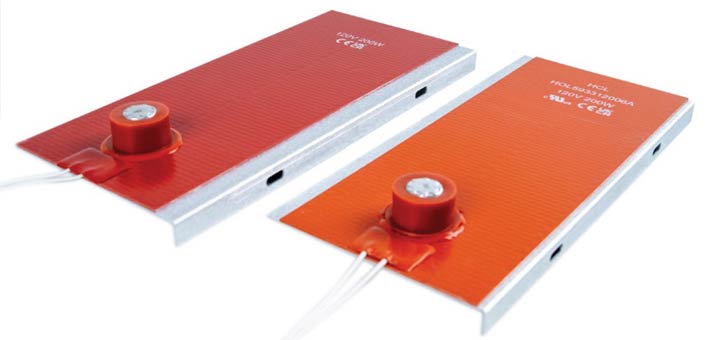
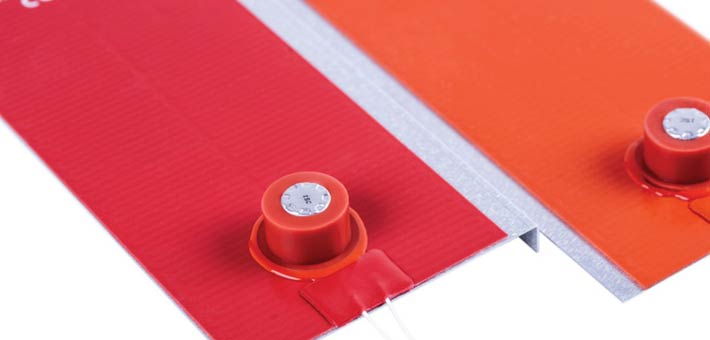

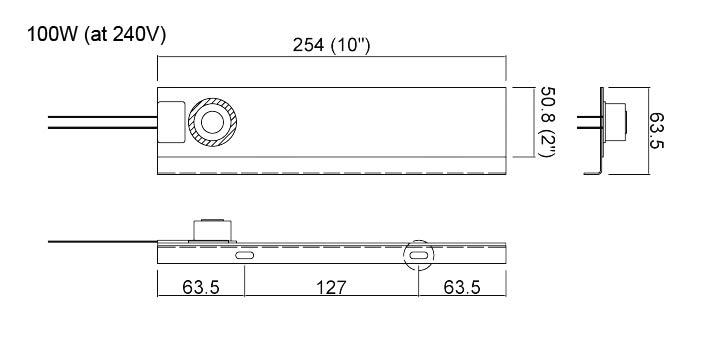
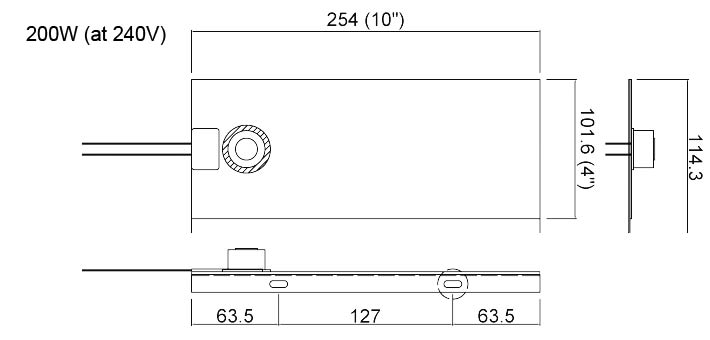
Installation note:
The Enclosure Heater are factory fitted to an aluminum mounting plate that allows for easy installation. The mounting surface is perpendicular to the heater and has two mounting holes. Heaters with integral thermostat should be vertically mounted with the sensor towards the base of the enclosure.
Downloads:
-
Flyer Silicone Heater Mats
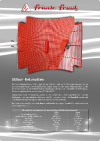
Flexible heating elements made from silicone or Kapton insulation are thin and lightweight so can be installed where space is limited, and due to their low mass they have a fast response to temperature control. The self-adhesive foil option allows for a quick and uncomplicated fixing. The operating temperatures range from -60°C to 200°C. (180°C With adhesive backing).
-
Surface Temperatures of Silicone Heater Mats
It is generally impossible to predict which temperature can be reached by a heater mat as there are plenty of influencing factors. Among them are beside the power, also weight and type of the material to be heated, ambient temperature, air flow and, naturally, the process control. The table shows which temperature will be reached on a mat in relation to the watt density and without temperature control.
- Operating Instructions Heater Mats & Foil Heaters
-
Really hot! Our Product Flyer.

Download our leaflet here.
